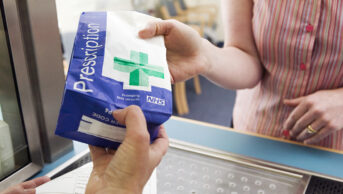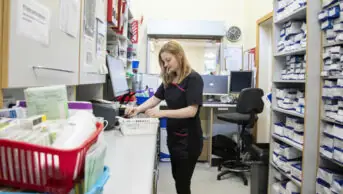
Shutterstock.com
Benefits of public engagement
There is a growing body of evidence to suggest that, if approached correctly, public engagement has more impact than traditional methods of health guidance and promotion (e.g. providing patients with leaflets or displaying posters to deliver important healthcare messages)[3] . Pharmacists should be proactive and adopt a different approach to healthcare guidance and promotion by going out into the community to educate and inform the general public about healthcare issues. There are many reasons for pharmacists to get involved and undertake activities focused on public engagement: it can help build trust and educate communities; support health promotion (particularly within hard-to-reach communities); and can raise aspirations among schoolchildren who would never have considered either going to university or viewing pharmacy as a potential career. Examples of public engagement activities can be found in Box 1. Pharmacists and pharmacy professionals already delivering engagement activities in their local communities understand their importance and utilise the opportunity to showcase skills that can aid their employment and promotion prospects, as well as their pharmacy’s services. In addition, they have the opportunity to field questions that may not be forthcoming in a formal setting and, above all, are able to strengthen links with the community. Engagement can be defined as a two-way process involving interaction and listening with the goal of generating mutual benefit. When well executed, public engagement can have a huge impact on all of the participants. The audience can encounter something new, or perhaps hear opinions and suggestions that could change their perspective or practice with respect to their health.Box 1: Examples of different types of activity covered by public engagement
There are two general types of format: traditional and interactive. Traditional formats:- Lectures;
- Talks.
- Workshop activities;
- Public debate;
- Dialogue and consultation.
- Museums;
- Galleries;
- Festivals;
- Exhibitions;
- Teachers and schools;
- Community-based organisations.
Considerations before getting started
There are four aspects pharmacy professionals should consider before getting started:- The purpose;
- The audience;
- The activity;
- Assessing the impact.
Purpose
Prior to the activity, it is important to think about why you want to engage the public and what the main messages are that you want to deliver. This can be challenging and it can be difficult to make a decision about the specific approach without knowing the purpose. The aim of the activity could be generic, for example, inspiring schoolchildren to take an interest in pharmacy as a viable career option[4] . Alternatively, it could be more specific, such as raising awareness about the threat of antimicrobial resistance (AMR) development[5] .Audience
Once the purpose of the activity has been established, it is then important to think about the audience in terms of who you will be engaging with. It is not sufficient to determine your audience as ‘the public’ — it is important to determine who the public are exactly, and how you can ensure that your engagement with them is effective. Essentially, ‘the public’ can include everyone, family and friends, school pupils, line managers and members of the local communities. School and community groups are probably the most common target groups. Having identified the audience, it is important to take time to understand their interests and needs — for example, why they might be interested in taking part in the public engagement activity. It may be helpful to build a profile of your target group: what they do; what they read; what they listen to; what they like to attend; and what they want to learn about. The better your understanding of the audience, the more successful the public engagement activity is likely to be. From the authors’ experience, when developing AMR workshops for high schools, in addition to looking at the GCSE Key Stage 4 curricula (followed by students in England, Wales and Northern Ireland aged 14–16 years), it was useful to meet with teachers and pupils to determine their existing level of knowledge and to find out what they thought would be helpful and informative in terms of content and approach[6] . A central point of contact in the target group can be helpful to liaise with because they can help develop the event and provide valuable insights, knowledge and contacts. They will know what works best for the group they are associated with, which could include knowledge of barriers that may limit the effectiveness of the planned activity. Examples of such barriers could be:- Ensuring the event is located in a place that the target audience regularly attends;
- Transport to the venue (availability and costs);
- Timing of the activity (during or after school and weekends);
- Interest (motivations and needs).
Activity
In addition to thinking about the purpose of the activity and the nature of the target audience, other main factors to consider are the topic that you are planning to cover and the resources that are available. Be realistic about the amount of time that it will take to prepare and run an activity, especially if this is the first time you have been involved with one, and whether you have appropriate resources at your disposal. People have different learning styles — some are visual, some auditory, while others prefer learning by carrying out physical activities (tactile learning). As such, it is worth considering a mix of approaches when devising the public engagement activity. An ideal entry-level activity for anyone new to public engagement is giving a public lecture or talk. These can be either arranged yourself through community contacts or through an engagement conduit such as Café Scientifique or SciBar. As these organisations often have a programme of talks, it can be helpful to visit a similar event beforehand to get a sense of audience engagement, to see what works and does not work, and the types of discussion that take place. For many pharmacists, their first experience of public engagement is working with a school. This might be through an existing programme run by the school, such as a careers event, or through a specific, individually organised activity. Audience involvement, engagement and participation are vital to any successful event — some helpful tips are included in Box 2.Box 2: How to involve the audience
Regardless of whether it is a public lecture or a school-based presentation, it is important to involve the audience wherever possible. By telling stories to annotate the talk:- Personal anecdotes are usually well received as long as no personal/confidential details are revealed.
- When talking to high school pupils about chlamydia/sexual health, graphic but real-life images of male and female genital infections helped put warnings into context;
- When showing data, (e.g. the rise in antibiotic resistance over the years), graphs are always better received than tables of data.
- In an antimicrobial resistance workshop developed by the authors, skittles were used to represent bacteria and balls were used to represent antibiotics, in order to illustrate bacterial resistance. Skittles knocked over were susceptible, those remaining standing were resistant. Removal of a second ball before rolling was equivalent to stopping a course of antibiotics too early, thereby leaving resistant cells (skittles) in place.
- A popular activity among schoolchildren of all ages is poster designing;
- Role play scenarios work well and can open up the whole group for more general discussion.
- This can take the form of asking the audience for a show of hands for optional answers to simple questions, for example, how many bacterial cells do you think are associated with the human body: 106, 1010 or 1014?
- Alternatively, more complex questions could be used to encourage debate (e.g. should antibiotics be treated as a controlled drug in order to reduce usage?). This very much depends upon the type of activity and the make-up of the audience.
Assessing the impact
At the end of the public engagement activity, ask for feedback on what the audience thought was useful, as it not only allows you to measure the impact of your public engagement work, but also enables you to learn from your experiences. In the authors’ experience, simple and anonymous is best; people do not generally want to complete complex evaluation questionnaires. This information can be shared with others and inform future activities. This may be a requirement if the activity forms part of a wider public engagement event or is sponsored by others. Feedback evaluation can take many formats, from semi-formal (but simple) ranking (Likert) questionnaires, to Post-it notes, a ‘tree of inspiration’, or simply just a show of hands. Pay attention to any feedback given because it may be valid, something you had not thought of, or something that could make the engagement activity more appealing or interesting. Remember that people may have different needs and this should be reflected in the offering. Public engagement should be a fun, inclusive and rewarding activity that removes barriers, educates communities, raises aspirations and improves health and life chances. In short, public engagement benefits everyone. Box 3 provides six tips for a successful public engagement activity.Box 3: Six top tips for successful public engagement
1. Aim Think carefully about what you want to achieve from your activity. 2. Audience Make sure that the activity is targeted appropriately and discussed with relevant individuals. 3. Listening Public engagement is a two-way dialogue — make sure you hear what your audience wants. 4. Content What types of activity are you going to do and how will you ensure that it caters for all learning types and is relevant to all? Be as interactive as possible. 5. Venue Take into account what will be most convenient, accessible and welcoming for your audience. 6. Marketing Consider how you will get community groups to attend your activity. Do you need to liaise with someone from the local community?Useful resources
Further guidance and resources are available at:- Media training and media facing roles in pharmacy — how media training benefits both pharmacists and pharmacy.
- Six tips on how to use social media to promote your pharmacy — how to optimise use of social media to develop and grow your pharmacy business.
Acknowledgement
The authors wish to thank A Bramwell for critically reading the manuscript.
- Deepening understanding of health inequalities
- This means developing an insight into the demographics of the population served by pharmacies using population health statistics and by engaging with patients directly through local community or faith groups.
- Understanding and improving pharmacy culture
- This calls on the whole pharmacy team to create a welcoming culture for all patients, empowering them to take an active role in their own care, and improving communication skills within the team and with patients.
- Improving structural barriers
- This calls for improving accessibility of patient information resources and incorporating health inequalities into pharmacy training and education to tackle wider barriers to care.
References
[1] The Academy of Medical Sciences. Improving the health of the public by 2040. 2016. Available at: https://acmedsci.ac.uk/file-download/41399-5807581429f81.pdf (accessed August 2018).
[2] Pharmaceutical Services Negotiating Committee. Healthy Living Pharmacies. 2018. Available at: https://psnc.org.uk/services-commissioning/locally-commissioned-services/healthy-living-pharmacies/ (accessed July 2018).
[3] Ashiru-Oredope D & Hopkins S. Antimicrobial resistance: moving from professional engagement to public action. J Antimicrob Chemother 2015;70(11):2927–2930. doi: 10.1093/jac/dkv297
[4] Lewis E, Williams E, Lewis P & Allison DG. Success4Life: an aspirational programme for looked after children. J Widening Participation & Lifelong Learning 2015;17(4):116–127. doi: 10.5456/WPLL.17.4.116
[5] Allison DG, Higginson P & Martin S. Antibiotic resistance awareness: a public engagement approach for all pharmacists. Int J Pharm Pract 2016;25(1):93–96. doi: 10.1111/ijpp.12287
[6] Allison DG & Hughes S. Antibiotic resistance awareness: spreading the word, not the worry. Perspect Public Health 2015;135(6):284–285. doi: 10.1177/1757913915606664


